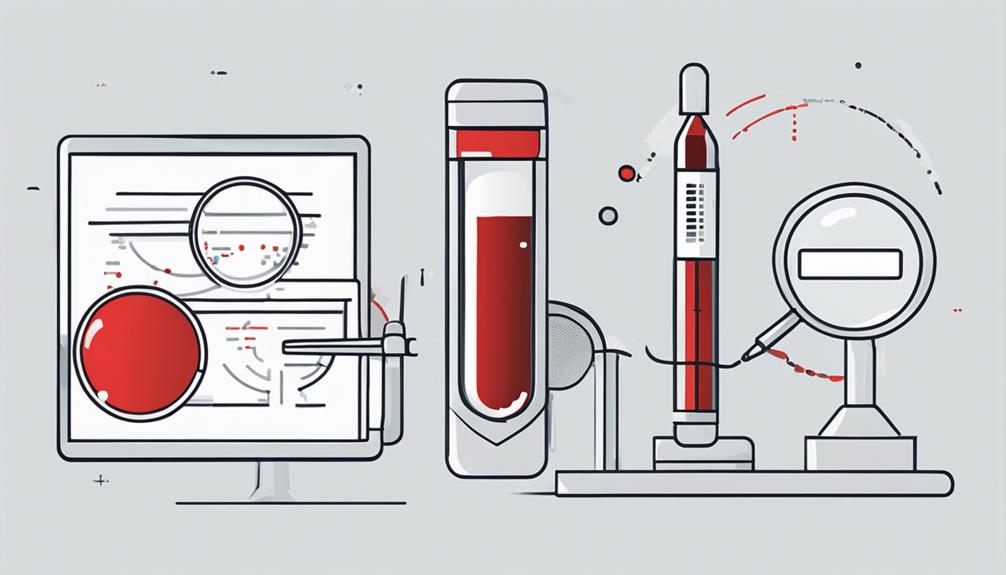When addressing the identification of Type 1 diabetes, it's essential to consider various key factors. From family medical backgrounds to specific blood tests, each aspect plays a crucial role in distinguishing this condition.
By analyzing these factors methodically, healthcare providers can accurately pinpoint the correct diagnosis. Remember, each piece of information contributes uniquely to the overall diagnostic puzzle, allowing for a comprehensive approach to understanding the complexities of Type 1 diabetes.
Key Takeaways
- Genetic factors play a crucial role in Type 1 Diabetes development.
- Symptom assessment aids in identifying rapid disease progression.
- Diagnostic testing for specific autoantibodies helps differentiate Type 1 from Type 2 diabetes.
- Monitoring biochemical markers and ketone levels guides treatment and complication detection.
Family History

When assessing for the differential diagnosis of Type 1 Diabetes, your first step should be to carefully review the individual's family history. Genetic predisposition plays a crucial role in the development of Type 1 Diabetes. It's essential to investigate the inheritance patterns within the family to determine the risk factors associated with the disease.
Examining the family history allows you to identify any close relatives who've been diagnosed with Type 1 Diabetes. Understanding the genetic predisposition can provide valuable insights into the likelihood of an individual developing the condition. By studying the inheritance patterns, you can determine if there's a familial clustering of Type 1 Diabetes, which could indicate a higher risk for the individual in question.
Analyzing the family history for genetic predisposition and inheritance patterns is fundamental in the differential diagnosis of Type 1 Diabetes. This detailed assessment enables healthcare professionals to make informed decisions regarding the individual's risk factors and potential development of the disease.
Onset of Symptoms
Upon initial assessment of a patient for Type 1 Diabetes, examining the timing and characteristics of symptom onset is crucial in determining the differential diagnosis. Symptom progression plays a significant role in understanding the nature of the disease.
In Type 1 Diabetes, symptoms typically progress rapidly over a few weeks, with individuals experiencing excessive thirst, frequent urination, unexplained weight loss, fatigue, and blurred vision. The age of onset is another critical factor to consider.
While Type 1 Diabetes can develop at any age, it most commonly presents in children, adolescents, or young adults. However, late-onset cases can also occur in individuals beyond these age ranges.
Understanding when the symptoms first appeared and how they've evolved can provide valuable insights into the disease's progression and severity. By carefully assessing the onset of symptoms and their progression, healthcare professionals can better differentiate Type 1 Diabetes from other conditions with similar presentations.
Blood Glucose Levels

Analyzing blood glucose levels is a fundamental aspect of diagnosing and monitoring Type 1 Diabetes. When evaluating blood glucose levels, consider the following key factors:
- Meal Timing: The timing of meals plays a crucial role in managing blood glucose levels. Understanding when to eat and how it affects your levels is essential for diabetes management.
- Exercise Intensity: Engaging in physical activity impacts blood glucose levels. Monitoring how different exercise intensities affect your levels can help in adjusting insulin doses or dietary intake accordingly.
- Consistency in Monitoring: Regularly monitoring blood glucose levels throughout the day provides valuable insights into patterns and trends, aiding in better management of Type 1 Diabetes.
- Response to Treatment: Observing how your blood glucose levels respond to insulin therapy and dietary changes can guide healthcare providers in adjusting treatment plans for optimal control.
Autoantibody Testing
When considering the differential diagnosis of Type 1 diabetes, it's crucial to understand the diagnostic significance of autoantibodies. These antibodies, such as GAD65, IA-2, and insulin autoantibodies, play a key role in identifying autoimmune destruction of pancreatic beta cells.
Autoantibody testing is particularly valuable in the early detection of Type 1 diabetes, aiding in prompt intervention and management strategies.
Diagnostic Significance of Autoantibodies
Autoantibody testing plays a crucial role in the differential diagnosis of Type 1 diabetes by identifying specific antibodies that target pancreatic beta cells. When considering the diagnostic significance of autoantibodies, there are several key points to keep in mind:
- Autoantibody Specificity: Different autoantibodies, such as anti-insulin antibodies and anti-glutamic acid decarboxylase antibodies, provide valuable information about the immune response targeting the pancreas.
- Diagnostic Accuracy: The presence of multiple autoantibodies, known as multiple autoantibody positivity, increases the likelihood of developing Type 1 diabetes.
- Predictive Value: Autoantibody testing can help predict the risk of progression from autoimmunity to clinical disease.
- Monitoring Progression: Regular monitoring of autoantibody levels can track the progression of pancreatic beta cell destruction over time.
Types of Autoantibodies Identified
Identifying the specific types of autoantibodies through testing is essential for gaining insights into the immune response and aiding in the differential diagnosis of Type 1 diabetes. In Type 1 diabetes, autoantibodies target various components involved in insulin production, mainly beta cells in the pancreas. These autoantibodies play a crucial role in the autoimmune response that leads to beta cell destruction.
Common autoantibodies tested for in Type 1 diabetes include anti-insulin, anti-GAD65, anti-IA2, and anti-ZnT8. Each of these autoantibodies targets a specific antigen, providing valuable information about the immune system's activity against pancreatic beta cells.
Role in Early Detection
Utilizing autoantibody testing plays a crucial role in the early detection of Type 1 diabetes by providing valuable insights into the immune response against pancreatic beta cells. This method aids in identifying individuals at risk even before symptoms appear, allowing for early intervention strategies to be implemented effectively.
The detection methods involved in autoantibody testing are highly sensitive and specific, enabling healthcare providers to distinguish between Type 1 and Type 2 diabetes accurately. By analyzing the presence of specific autoantibodies targeting beta cells, clinicians can make informed decisions regarding the appropriate management and treatment plans for patients. Early detection through autoantibody testing enhances the overall prognosis and quality of life for individuals with Type 1 diabetes.
- Early intervention strategies can be tailored promptly.
- Specific autoantibodies can be identified accurately.
- Enables differentiation between Type 1 and Type 2 diabetes.
- Improves overall management and treatment outcomes.
C-Peptide Levels
When assessing C-peptide levels, you'll consider its diagnostic significance in differentiating between type 1 and type 2 diabetes. Understanding the interpretation of C-peptide levels in a clinical context is crucial for accurate diagnosis and treatment planning.
Analyzing these levels methodically can provide valuable insights into the underlying pathophysiology of the disease.
Diagnostic Significance of C-Peptide
C-Peptide levels play a crucial role in the differential diagnosis of Type 1 diabetes. Understanding the diagnostic significance of C-Peptide levels can provide valuable insights into the patient's condition.
- Hormone Regulation: C-Peptide levels reflect the endogenous production of insulin, aiding in distinguishing between Type 1 and Type 2 diabetes.
- Beta Cell Function: Measurement of C-Peptide levels helps assess beta cell function, crucial for determining the appropriate treatment plan.
- Insulin Secretion: Low C-Peptide levels indicate reduced insulin secretion, characteristic of Type 1 diabetes.
- Treatment Guidance: C-Peptide levels can guide healthcare professionals in tailoring treatment strategies based on the patient's insulin production capacity.
Interpretation in Clinical Practice
In clinical practice, understanding the implications of C-Peptide levels is essential for guiding proper treatment decisions and assessing the patient's insulin production status. C-Peptide levels have significant clinical implications, aiding in the differentiation between type 1 and type 2 diabetes, despite diagnostic challenges.
Low C-Peptide levels often indicate decreased endogenous insulin production, characteristic of type 1 diabetes, while higher levels may suggest preserved beta-cell function as seen in type 2 diabetes. These insights are crucial for treatment considerations and patient management.
For instance, in type 1 diabetes, where C-Peptide levels are typically low, exogenous insulin therapy is imperative. Conversely, in type 2 diabetes, higher C-Peptide levels may guide therapy towards medications that improve insulin sensitivity rather than solely focusing on insulin replacement.
Understanding C-Peptide levels enhances personalized care and optimizes treatment strategies.
Ketone Testing

To ensure accurate monitoring of ketone levels in individuals with type 1 diabetes, regular ketone testing is crucial for early detection of potential complications. When managing your diabetes, paying attention to your ketone levels is key. Here are some essential points to consider:
- Frequency: Test your ketone levels regularly, especially if you're sick or your blood sugar levels are consistently high.
- Timing: Perform ketone testing whenever your blood sugar levels are above 240 mg/dL or as advised by your healthcare provider.
- Interpretation: Understand the results of your ketone tests and take appropriate actions based on the guidelines provided by your healthcare team.
- Hydration: Stay well-hydrated to help prevent ketone build-up, particularly during illness or periods of high blood sugar.
Insulin Levels
When considering the differential diagnosis of Type 1 diabetes, understanding the intricate mechanisms of insulin secretion is crucial.
Factors contributing to insulin resistance also play a significant role in this diagnostic process.
Analyzing these points meticulously can provide valuable insights for accurate differentiation between Type 1 diabetes and other conditions.
Insulin Secretion Mechanism
Upon receiving signals from the bloodstream, pancreatic beta cells release insulin in response to elevated glucose levels.
- Insulin facilitates the uptake of glucose by cells for energy production.
- The release of insulin is tightly regulated to maintain blood glucose levels within a narrow range.
- Beta cells continuously monitor blood glucose levels to adjust insulin secretion accordingly.
- Insulin secretion is a crucial aspect of glucose metabolism, ensuring proper utilization of glucose for cellular functions.
Understanding the intricate mechanism of insulin secretion and its relationship to glucose metabolism is essential in comprehending the role of beta cell function in maintaining overall metabolic balance. This process forms the foundation for diagnosing and managing conditions like Type 1 Diabetes effectively.
Insulin Resistance Factors
Insulin levels play a critical role in determining the body's response to glucose uptake and utilization. Insulin sensitivity, which refers to how effectively cells respond to insulin, is a key factor in insulin resistance.
When cells become less sensitive to insulin, they require higher levels of insulin to facilitate glucose uptake, leading to elevated insulin levels in the bloodstream. This increased demand on the pancreas can put a strain on beta cell function, as these cells are responsible for producing insulin.
Over time, if beta cells are unable to keep up with the body's insulin needs, insulin resistance can worsen, potentially leading to conditions like type 2 diabetes. Monitoring insulin levels and promoting insulin sensitivity through lifestyle modifications are crucial in managing insulin resistance.
HbA1c Levels

Understanding the significance of HbA1c levels is crucial for accurate differential diagnosis of Type 1 diabetes.
When evaluating HbA1c levels, several key factors come into play:
- HbA1c Variability: Assessing the variability in HbA1c levels over time can provide insights into the stability of blood glucose control, aiding in the differentiation of Type 1 diabetes from other conditions.
- Predictive Modeling: Utilizing predictive modeling techniques can help in estimating future HbA1c levels based on current data, assisting in the early detection of Type 1 diabetes.
- Target Levels: Knowing the target HbA1c levels for individuals with Type 1 diabetes is essential for comparison and interpretation of test results.
- Clinical Correlation: Interpreting HbA1c levels in conjunction with clinical symptoms and other diagnostic tests is crucial for a comprehensive differential diagnosis.
Differential Diagnosis Tools
To aid in the accurate differential diagnosis of Type 1 diabetes, utilizing specialized tools for differential diagnosis is essential. Diagnostic algorithms play a crucial role in this process by guiding healthcare professionals through a systematic approach to evaluating patients with symptoms suggestive of Type 1 diabetes. These algorithms are based on established clinical guidelines and diagnostic criteria, helping to distinguish Type 1 diabetes from other conditions with similar presentations.
Clinical guidelines provide a framework for healthcare providers to follow when considering the differential diagnosis of Type 1 diabetes. By adhering to these guidelines, practitioners can ensure that the appropriate tests and assessments are conducted to reach an accurate diagnosis. Diagnostic criteria further assist in differentiating Type 1 diabetes from other forms of diabetes or metabolic disorders, enabling healthcare professionals to make informed decisions regarding treatment and management.
Misdiagnosis Considerations

Consider the potential pitfalls in the diagnostic process to prevent misdiagnosis of Type 1 diabetes. When evaluating a patient for Type 1 diabetes, it's crucial to be aware of certain considerations that can lead to misdiagnosis. Here are some key points to keep in mind:
- Symptom variability: Symptoms of Type 1 diabetes can vary widely from person to person. While some individuals may present with classic symptoms such as excessive thirst and frequent urination, others may exhibit more subtle signs like unexplained weight loss or fatigue. This variability can make it challenging to identify the condition, leading to potential misdiagnosis.
- Age differences: Type 1 diabetes can occur at any age, but it's most commonly diagnosed in children, adolescents, and young adults. However, it can also develop in older individuals. The presentation of symptoms and the progression of the disease may differ based on the age of the individual, making it essential to consider age differences when making a diagnosis.
Being mindful of symptom variability and age differences can help healthcare providers avoid misdiagnosis and ensure that patients receive timely and accurate care for Type 1 diabetes.
Frequently Asked Questions
What Are the Potential Complications of Misdiagnosing Type 1 Diabetes?
Misdiagnosing type 1 diabetes can lead to severe complications like diabetic ketoacidosis, nerve damage, and vision problems. Improper treatment may result in patient outcomes worsening, medical errors, and increased healthcare costs.
How Does Type 1 Diabetes Differ From Type 2 Diabetes in Terms of Treatment and Management?
When managing type 1 diabetes, insulin therapy is essential for regulating blood sugar levels. Glucose monitoring helps track changes, guiding treatment adjustments. Dietary modifications and exercise routines play critical roles in maintaining stable blood sugar levels and overall health.
Are There Any Genetic Factors That Can Influence the Development of Type 1 Diabetes?
Genetic predisposition plays a crucial role in the development of type 1 diabetes. Disease progression can be influenced by familial history. Even with genetic factors at play, lifestyle choices and environmental triggers also impact the condition.
Can Type 1 Diabetes Be Prevented or Delayed Through Lifestyle Changes or Interventions?
You can potentially prevent or delay the onset of type 1 diabetes through lifestyle modifications like maintaining a healthy weight, eating a balanced diet, and staying physically active. Intervention strategies involving close monitoring and early detection can also help delay its progression.
What Are the Long-Term Implications of Living With Type 1 Diabetes in Terms of Overall Health and Quality of Life?
Mentally, managing type 1 diabetes brings challenges, impacting health and life quality. Diligent disease management strategies are crucial. Stay strong, seek support, and strive for balance to navigate the impact on mental health.
Conclusion
In conclusion, when differentiating type 1 diabetes, considering factors such as family history, onset of symptoms, blood glucose levels, autoantibody testing, and C-peptide levels is crucial.
Insulin and HbA1c levels, along with differential diagnosis tools, play a key role in accurate diagnosis.
Despite advancements in diagnostic techniques, it's surprising that misdiagnosis of type 1 diabetes still occurs in up to 30% of cases, highlighting the importance of thorough evaluation and clinical judgment.